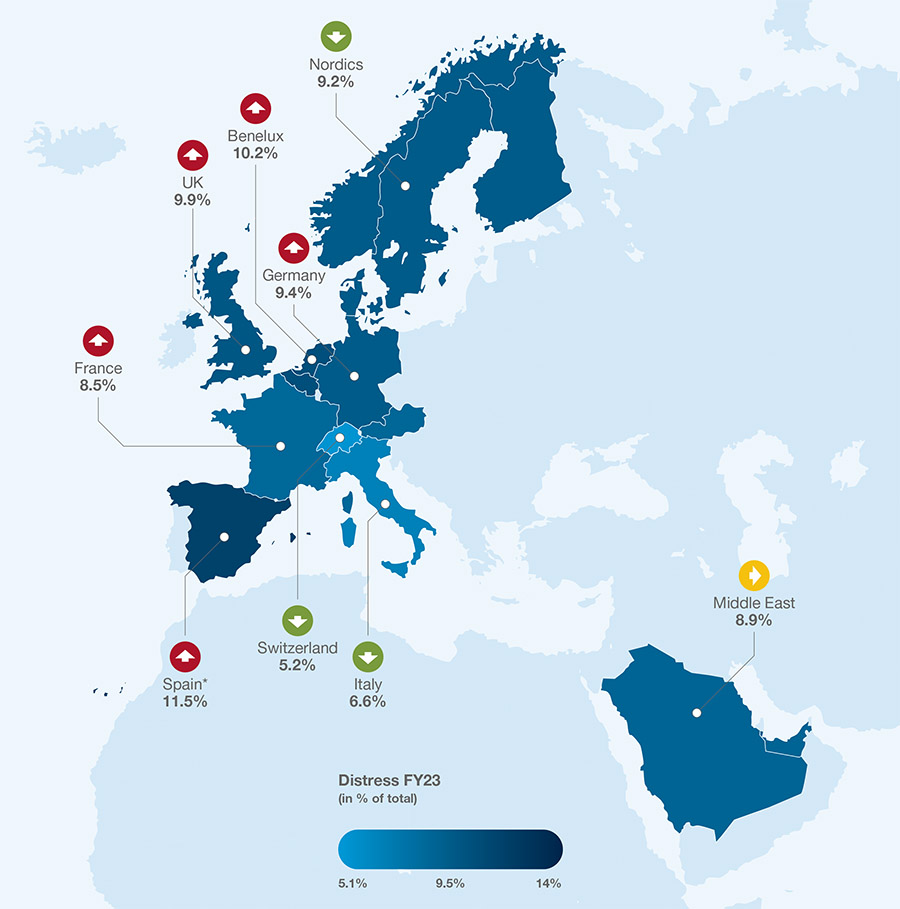Compared to the previous year, the level of corporate distress in Europe has increased by 10%, with the United Kingdom and Germany continuing to be among the most distressed markets in Europe. According to the findings of a recent study, the economy of the United Kingdom is still grappling with the decrease in disposable income among its consumers, which leaves many firms that are focused on providing services vulnerable.
With more than 10,000 employees spread across six continents, Alvarez & Marsal (A&M) provides consulting services to corporations, boards of directors, private equity firms, law firms, and government agencies all over the world. This includes the A&M Distress Alert, which is issued twice a year and evaluates the financial performance and balance sheet robustness of more than 8,200 enterprises across Europe. The alert is issued every other year.
The research focuses on an index that analyzes 18 key performance indicators (KPIs) to generate two sub-scores: the performance score, which is derived from the company’s own income statement as well as related KPIs assessed against its peers in the industry; and the robustness score, which is derived from detailed balance sheet data information. Including both privately held and publicly traded businesses with annual revenues of more than twenty million euros, the scores are assigned on a scale ranging from zero, which indicates the most severely affected, to ten, which indicates the most financially stable.

Source: Alvarez & Marsal
This methodology has found that the number of firms in corporate distress in Europe has risen by 10% year-on-year, with some 9.2% of the continent’s corporations now in distress. At the same time, 10 of Europe’s 16 industrial sectors saw a deterioration in corporate financial health, according to A&M, while 55% of countries saw distress levels rise.
The analysis also suggests the situation may further deteriorate in the near future, with ‘healthy’ companies in increasingly shaky positions too. The figures show that the share of businesses with weak balance sheets across Europe has reached a record 31.2%, which represents over 2,500 corporations. This reflects the negative effects of slower consumer spending and rising expenses brought on by inflation, which are reducing businesses’ ability to service their debt. With interest rates still high and inflation still not falling rapidly, those companies will come under growing strain.
Chris Johnston, European co-head of financial and operational restructuring at A&M, said, “We still see significant challenges for corporates in the latter part of 2024 and into 2025. Economic growth across Europe remains weak and consumer spending is depressed, hitting corporate performance and weakening the ability of highly leveraged businesses to pay down their debt. It is now unavoidable that we will see an increase in restructuring activity, particularly as refinancing dates come closer.”

The United Kingdom is suffering more distress than a large majority of the continent, suggesting that these trends are having an especially negative impact on the health of businesses in that nation. A&M’s information shows that 9.9% of all enterprises are currently having financial difficulties, up from 8.4% one year earlier. This indicates the highest yearly growth rate among all the countries examined in the research.
Furthermore, A&M managing director Alessandro Farsaci said, “Consumer demand continues to be a drag on key sectors.” Consumer spending is still constrained, even though some economic indicators are beginning to improve. This is because consumers have not yet felt the full effect on their wallets. This will be a source of worry for management teams in a wide range of various companies. It will become harder to pay off debt since cash flow and profitability are being squeezed, and over the course of the next twelve to eighteen months, we might see more challenging refinancings and more insolvencies.
For example, the experts’ conclusions indicate that pressures on discretionary income are a major factor contributing to the trend of decline in the fashion retail industry. In the United Kingdom, this sector is witnessing the worst trend, with a 14.4% increase in the number of underperforming businesses, accounting for 21% of all businesses. These pressures also had an impact on the media and entertainment services business, as consumers cut back on their discretionary spending. This was in line with the consequences of the multi-month Hollywood strikes, which halted production on a number of projects and decreased the amount of new merchandise available for purchase. Because of this, the media industry—which makes up 21.6% of the total—is the most harmful to businesses that are having problems.